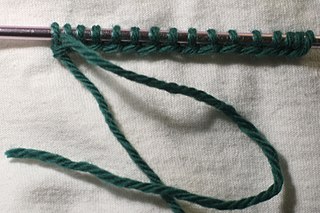Crochet is a process of creating textiles by using a crochet hook to interlock loops of yarn, thread, or strands of other materials. The name is derived from the French term crochet, which means 'hook'. Hooks can be made from a variety of materials, such as metal, wood, bamboo, bone or even plastic. The key difference between crochet and knitting, beyond the implements used for their production, is that each stitch in crochet is completed before the next one is begun, while knitting keeps many stitches open at a time. Some variant forms of crochet, such as Tunisian crochet and broomstick lace, do keep multiple crochet stitches open at a time.

Knitting is a method for production of textile fabrics by interlacing yarn loops with loops of the same or other yarns. It is used to create many types of garments. Knitting may be done by hand or by machine.

Needlework is decorative sewing and textile arts handicrafts. Anything that uses a needle for construction can be called needlework. Needlework may include related textile crafts such as crochet, worked with a hook, or tatting, worked with a shuttle.

Yarn is a long continuous length of interlocked fibres, used in sewing, crocheting, knitting, weaving, embroidery, ropemaking, and the production of textiles. Thread is a type of yarn intended for sewing by hand or machine. Modern manufactured sewing threads may be finished with wax or other lubricants to withstand the stresses involved in sewing. Embroidery threads are yarns specifically designed for needlework. Yarn can be made of a number of natural or synthetic materials, and comes in a variety of colors and thicknesses. Although yarn may be dyed different colours, most yarns are solid coloured with a uniform hue.
This timeline of clothing and textiles technology covers events relating to fiber and flexible woven material worn on the body. This includes the making, modification, usage, and knowledge of tools, machines, techniques, crafts, and manufacturing systems (technology).

A knitting needle or knitting pin is a tool in hand-knitting to produce knitted fabrics. They generally have a long shaft and taper at their end, but they are not nearly as sharp as sewing needles. Their purpose is two-fold. The long shaft holds the active (unsecured) stitches of the fabric, to prevent them from unravelling, whereas the tapered ends are used to form new stitches. Most commonly, a new stitch is formed by inserting the tapered end through an active stitch, catching a loop of fresh yarn and drawing it through the stitch; this secures the initial stitch and forms a new active stitch in its place. In specialized forms of knitting the needle may be passed between active stitches being held on another needle, or indeed between/through inactive stitches that have been knit previously.

Stockings are close-fitting, variously elastic garments covering the leg from the foot up to the knee or possibly part or all of the thigh. Stockings vary in color, design, and transparency. Today, stockings are primarily worn for fashion and aesthetics, usually in association with mid-length or short skirts.

Circular knitting or knitting in the round is a form of knitting that creates a seamless tube. Work in the round is begun by casting on stitches as for flat knitting but then joining the ends of that row of stitches to form a circle. Knitting is worked in rounds, which forms the tube by winding around in a helix.

Knitting is the process of using two or more needles to pull and loop yarn into a series of interconnected loops in order to create a finished garment or some other type of fabric. The word is derived from knot, thought to originate from the Dutch verb knutten, which is similar to the Old English cnyttan, "to knot". Its origins lie in the basic human need for clothing for protection against the elements. More recently, hand knitting has become less a necessary skill and more of a hobby.

Nålebinding is a fabric creation technique predating both knitting and crochet. Also known in English as "knotless netting", "knotless knitting", or "single-needle knitting", the technique is distinct from crochet in that it involves passing the full length of the working thread through each loop, unlike crochet where the work is formed only of loops, never involving the free end. It also differs from knitting in that lengths must be pieced together during the process of nålebinding, rather than a continuous strand of yarn that can easily be pulled out. Archaeological specimens of fabric made by nålebinding can be difficult to distinguish from knitted fabric.

Armenian needlelace is a pure form of needle lace made using only a needle, thread and pair of scissors.

A stocking frame was a mechanical knitting machine used in the textiles industry. It was invented by William Lee of Calverton near Nottingham in 1589. Its use, known traditionally as framework knitting, was the first major stage in the mechanisation of the textile industry, and played an important part in the early history of the Industrial Revolution. It was adapted to knit cotton and to do ribbing, and by 1800 had been adapted as a lace making machine.

Rug hooking is both an art and a craft where rugs are made by pulling loops of yarn or fabric through a stiff woven base such as burlap, linen, or rug warp. The loops are pulled through the backing material by using a crochet-type hook mounted in a handle for leverage. In contrast latch-hooking uses a hinged hook to form a knotted pile from short, pre-cut pieces of yarn.

A knitting machine is a device used to create knitted fabrics in a semi or fully automated fashion. There are numerous types of knitting machines, ranging from simple spool or board templates with no moving parts to highly complex mechanisms controlled by electronics. All, however, produce various types of knitted fabrics, usually either flat or tubular, and of varying degrees of complexity. Pattern stitches can be selected by hand manipulation of the needles, push-buttons and dials, mechanical punch cards, or electronic pattern reading devices and computers.

In knitting, casting on is a family of techniques for adding new stitches that do not depend on earlier stitches, i.e., having an independent lower edge. In principle, it is the opposite of binding off, but the techniques involved are generally unrelated.
Knitting abbreviations are often used for brevity in describing knitting patterns.
The manufacture of textiles is one of the oldest of human technologies. To make textiles, the first requirement is a source of fiber from which a yarn can be made, primarily by spinning. The yarn is processed by knitting or weaving, with color and patterns, which turns it into cloth. The machine used for weaving is the loom. For decoration, the process of coloring yarn or the finished material is dyeing. For more information of the various steps, see textile manufacturing.

Jersey is a knit fabric used predominantly for clothing manufacture. It was originally made of wool, but is now made of wool, cotton and synthetic fibers.

Cowichan knitting is a form of knitting characteristic of the Cowichan people of southeastern Vancouver Island, British Columbia. The distinctively patterned, heavy-knit Cowichan sweaters, popular among British Columbians and tourists, are produced using this method. Cowichan knitting is an acculturated art form, a combination of European textile techniques and Salish spinning and weaving methods. From this union, new tools, techniques and designs developed over the years.

Twined knitting is a traditional Scandinavian knitting technique. It refers to knitting where two strands of yarn are knitted into the fabric alternatively and twisted once and always in the same direction before every stitch. The technique is called tvåändsstickning in Swedish, tvebandsstrikking in Norwegian, and tvebinding in Danish. Their literal meaning is "two-end knitting", referring to the traditional way of knitting with both yarn ends from one ball of yarn.


















